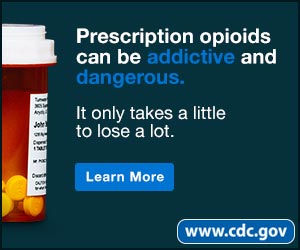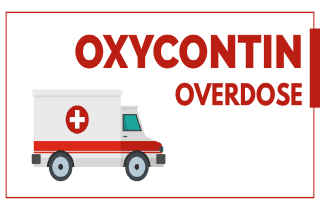READING SUMMARY: Yes, you can overdose on OxyContin; how much is takes to OD depends on your personal tolerance level to opiates. Higher dose, higher risk to OD.
TABLE OF CONTENTS
- Statistics
- Reasons
- How Overdose Happens
- Symptoms
- Dosing Limits
- Safe Doses
- Medications
- Prognosis
- When to Ask for Help
Statistics
The Centers for Disease Control (CDC) reports that 2016 painkiller ODs are on the rise. In fact, opioids (synthetic painkiller prescription meds like OxyContin ) were involved in 42,249 deaths in 2016. In 2016, the number of overdose deaths was 5 times higher than in 1999. Why is this happening?
In 2013, physicians wrote nearly a quarter of a billion painkiller prescriptions. This is enough for every American adult to have their own bottle of pills.
According to CDC records the opioid epidemic continues to grow in the United States.,,partly fueled by the popularity of oxycodone. The CDC rates OxyContin in the top 3 most common drugs involved in prescription opioid overdose deaths.
On average, 115 Americans die every day from an opioid overdose.
Reasons for OxyContin Overdose
People overdose on oxycodone, the main ingredient in OxyContin accidentally or when trying to get high..
Most common causes of accidental overdose are initiated by users who are increasing dosing to get pain relief. But increasing any dosing amounts or frequency can lead to can overdose. Sometimes, people take too much OxyContin on purpose, in an attempt to achieve a euphoric “high” but overdose in the process. This is a risk especially for people who haven’t had much exposure to OxyContin in the past.
Overdose occurs mainly because of:
- Drug tolerance. People who are taking OxyContin daily for a few weeks or longer can develop a tolerance to OxyContin, which is a blunting of the drug’s effects on the nervous system. When someone is “tolerant”, s/he feels the need to take more of the drug to achieve initial effects. However, higher dosages haven’t been shown to reduce pain over the long term. In these cases, reduction or tapering, asking for a naloxone prescription, or finding new pain treatments can lower overdose risk.
- Accidental ignorance. Not all overdoses are intentional; some happen accidentally. When people misread their prescriptions, or forget that they took their medication already it is very easily to reach intoxication. Sometimes, people can overdose when they use OxyContin and drink alcohol at the same time.This is why doctors highly advise users to stick to the medication guide and the exact prescribed doses.
- People try to get high. First time users or even drug dependent users who take OxyContin for euphoric effect are at special risk of overdose.
And to be clear: OxyContin abuse increases your risk of death and overdose. This is why OxyContin should only be taken swallowed as a whole pill, and only in the doses recommended by your doctor. You’re much more likely to overdose when you chew, crush, snort or inject OxyContin pills.
How Overdose Happens
An overdose is the result of taking more OxyContin than your body can metabolize. When you exceed the prescribed dose limits, your breathing slows down. Due to the biological reactions of intoxication, your brain lacks oxygen. If you begin to lose consciousness and do not receive immediate medical help, brain damage or death is possible.
Overdose Symptoms
Symptoms of OxyContin overdose include:
- confusion
- delirium
- frequent vomiting
- pinpoint pupils
- drowsiness
- inability to wake up
- loss of consciousness
- slowed or irregular breathing
- respiratory arrest
The most dangerous side effects that can happen during an opioid intoxication is depressed breathing. Lack of oxygen to the brain can cause permanent neurological damage. If you experience an opioid overdose and are alone and asleep, you could easily die your respiratory depression worsens.
NOTE: You may lose consciousness when experiencing an OxyContin overdose. But the most dangerous complication of OxyContin overdose is slowed or shallow breathing. An OxyContin overdose can even cause your breathing to stop, if you take enough of the drug. While you are still conscious call 911 IMMEDIATELY.
Taking two 15mg oxycodone tablets, 20-50 morphine milligram equivalents (MME) per day, increases your risk of an OxyContin overdose.
How Much Is Too Much?
Higher dosages of opioids like OxyContin are associated with higher risk of overdose and death—even at relatively low dosages. According to this CDC Total Daily Dose Calculator, if you are taking 20-50 morphine milligram equivalents (MME) per day, or 33 mg of oxycodone (~2 tablets of oxycodone sustained-release 15 mg) you are at increased risk of an overdose.
How much OxyContin can you take at once? One every 12 hours. And safe dosing levels of OxyContin depend on the strength of OxyContin you’ve been prescribed. Just one 60 mg tablet could be dangerous if you’ve never taken the drug before. You can follow a few basis guidelines to stay safe: a single dose of more than 40 mg OxyContin, or total daily doses greater than 80 mg, is too much for someone who’s just started the medicine. Always be careful to follow your doctor’s instructions when trying this medication for the first time.
The amount of OxyContin that is safe for you depends on whether you’ve recently been exposed to opioid medications or have developed a tolerance to narcotics. Your tolerance to OxyContin may require you to take a higher dose than someone just starting out. So be sure to always follow your doctor’s guidelines and always seek medical advice and supervision when you feel ready to increase dosing amounts or frequency.
Safe Doses
Single doses of immediate release oxycodone start at 5-15 mg every 4 to 6 hours. These doses can be increased only in consultation with your doctor if there is a real need for a dose adjustment. Keep in mind that each change in doses exposes you to the risk of developing tolerance. So safe dosing for opioid naive people is between 5 to 15 mg of oxycodone immediate release formulas taken at once.
Medications To Reverse Overdose
Naloxone is considered to be the most important treatment for opioid overdose. ERs usually use this medication to reverse opioid overdoses.
Naloxone binds to the same receptors in the brain as OxyContin, preventing it from creating a “high” for an hour after administration.
Naloxone can be an effective “antidote” for opioid overdose but the success of the outcome depends on the amount of OxyContin taken, as well as whether you took your medication in combination with alcohol or other substances. In severe cases, naloxone may not fully reverse the effects of an overdose, or may even require multiple administered doses and medical intervention from doctors. Because of the uncertainty, it is best to call 911 for emergency medical help instead of trying to resolve the situation by yourself.
Prognosis
An OxyContin overdose will not always be fatal. As long as breathing hasn’t been compromised, you can usually recover without long-term health effects. Still, it’s important to seek medical attention immediately if you believe you’ve taken too much OxyContin or suspect someone else has overdoses. If you delay treatment, an OxyContin overdose can be deadly or can result in permanent brain damage due to the lack of oxygen to the brain.
Furthermore, serious cases of OxyContin overdose may require that doctors administer oxygen to help you breathe. Sometimes, in near fatal cases of an OxyContin OD, medicine is given to counteract the effects of OxyContin.
When to Ask for Help
If you’re having a hard time with alcohol or OxyContin, or both…you are not alone!
An estimated 22 million people in the U.S. need help for addiction.
Ask for help earlier rather than later. You can get help by calling our hotline number here or by taking a self-assessed drug screen recommended by NIDA. Nothing gets better until you’re ready. So, reach out. A better life is waiting for you.

Questions
If you have any questions about safe amounts of OxyContin in your system, please leave them here. We are happy to try to help answer your questions about OxyContin, and will try to respond with a personal and prompt reply for all legitimate queries.










Related Posts